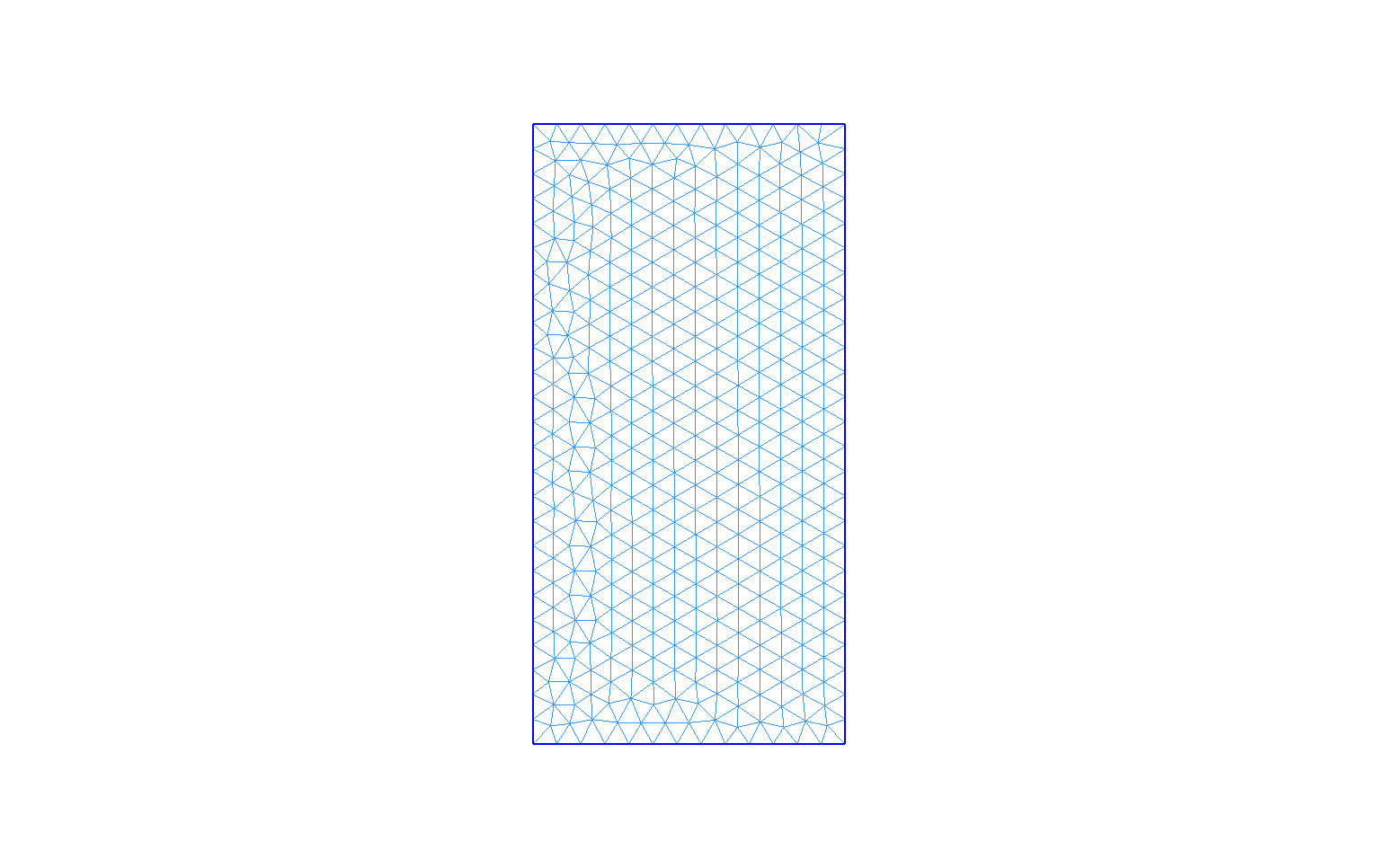Test Case of Thermal Dilatation in Axisymmetrical Coordinates Static in Vectorial Form
1. Introduction
This page presents the test case of Thermal Dilatation implement with CFPDEs with constant temperature without volumic force in static and axisymmetrical case, solve in vectorial form. This simulation have goal to verify the implementation of thermal dilatation.
2. Run the calculation
The command line to run this case is :
mpirun -np 16 feelpp_toolbox_coefficientformpdes --config-file=thermal-dilatation.cfg --cfpdes.gmsh.hsize=5e-3
3. Data Files
The case data files are available in Github here :
-
CFG file - Edit the file
-
JSON file - Edit the file
-
GEO file - Edit the file
4. Equation
The domain of resolution is \(\Omega_c^{axis}\) with bounds \(\Gamma_c^{axis}\), \(\Gamma_{D \hspace{0.05cm} elas}^{axis}\) the bound of elastic Dirichlet conditions, \(\Gamma_{N \hspace{0.05cm} elas}^{axis}\) the bound of elastic Neumann conditions such that \(\Gamma_c^{axis} = \Gamma_{D \hspace{0.05cm} elas}^{axis} \cup \Gamma_{N \hspace{0.05cm} elas}^{axis}\).
With :
|
|
|
|
And notations :
-
Divergence of tensor : \(\nabla \cdot \bar{\bar{\sigma}} = \begin{pmatrix} \nabla \cdot \bar{\bar{\sigma}}_{r,:} + \frac{\bar{\bar{\sigma}}_{rr} - \bar{\bar{\sigma}}_{\theta \theta}}{r} \\ \nabla \cdot \bar{\bar{\sigma}}_{z,:} + \frac{\bar{\bar{\sigma}}_{rz}}{r} \end{pmatrix}\)
-
Scalar produce of tensor : \(\bar{\bar{\sigma}} \cdot \mathbf{n} = \begin{pmatrix} \bar{\bar{\sigma}}_{r,:} \cdot \mathbf{n}^{axis} \\ \bar{\bar{\sigma}}_{z,:} \cdot \mathbf{n}^{axis} \end{pmatrix} = \begin{pmatrix} \bar{\bar{\sigma}}_{rr} \, n_r + \bar{\bar{\sigma}}_{rz} \, n_z \\ \bar{\bar{\sigma}}_{zr} \, n_r + \bar{\bar{\sigma}}_{zz} \, n_z\end{pmatrix}\)
5. Geometry
The geometry is a torus of the conductor in cartesian coordinates \((x,y,z)\) or rectangle in axisymmetric coordinates \((r,z)\), surrounded by air.
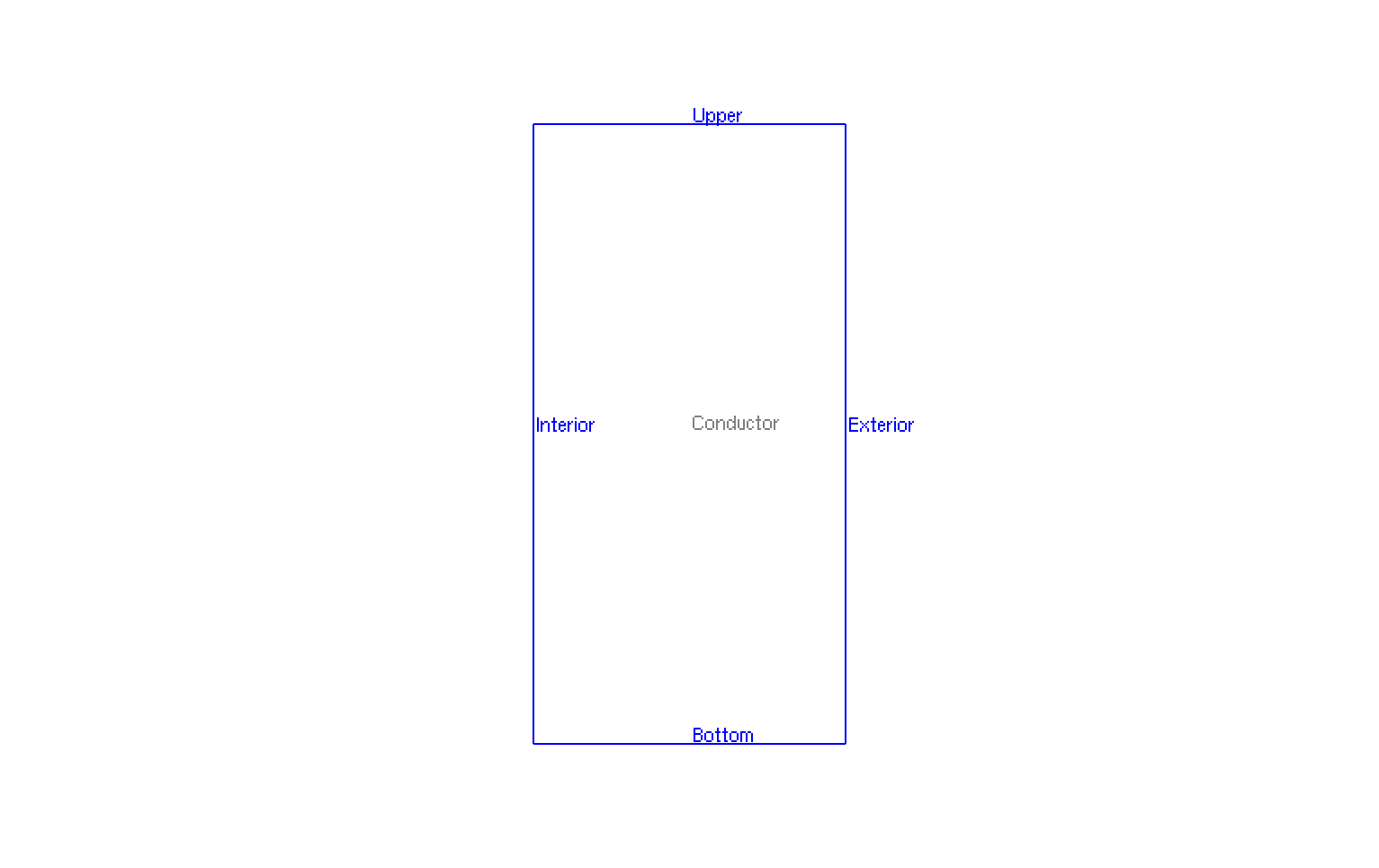
Axisymmetrical cut of Geometry
|
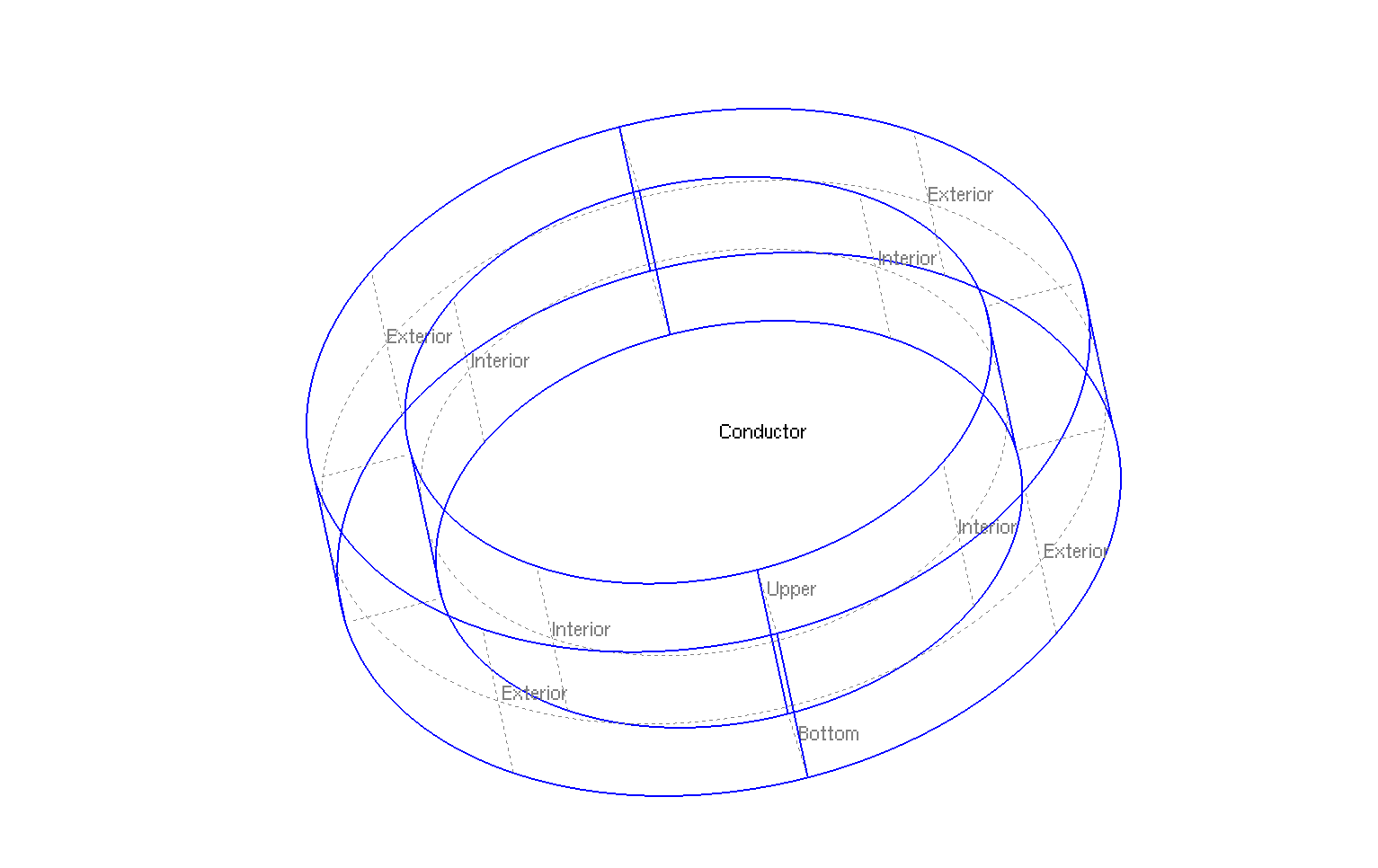
Geometry in Three Dimensions
|
The geometrical domains are :
-
Conductor: the torus is composed by conductor material-
Interior: interior surface of conductor ring -
Exterior: exterior surface of conductor ring -
Upper: upper of conductor ring -
Bottom: bottom of conductor ring
-
-
Air: the air surroundConductor-
zAxis: a bound ofAir, correspond to \(Oz\) axis (\(\{(z,r), \, z=0 \}\)) -
infty: the rest of bound ofAir
-
Symbol |
Description |
value |
unit |
\(r_{int}\) |
interior radius of torus |
\(75e-3\) |
m |
\(r_{ext}\) |
exterior radius of torus |
\(100.2e-3\) |
m |
\(z_1\) |
half-height of torus |
\(25e-3\) |
m |
6. Boundary Conditions
We impose the boundary conditions :
-
Strong Dirichlet : \(\mathbf{u} = 0\) on
UpperandBottom. The Dirichlet condition represents the embedding of mechanical part. -
Neumann : \(\bar{\bar{\sigma}} \cdot \mathbf{n} = 0\) on
InteriorandExterior. The Neumann condition represents the freedom of displacement.
On JSON file, the boundary conditions are writed :
"BoundaryConditions":
{
"elastic":
{
"Dirichlet":
{
"Bottom":
{
"expr":"{0,0}"
},
"Upper":
{
"expr":"{0,0}"
}
}
}
}
7. Weak Formulation
We obtain :
8. Parameters
The parameters of problem are :
Symbol |
Description |
Value |
Unit |
\(E\) |
Young Modulus |
\(2.1e6\) |
\(Pa\) |
\(v\) |
Poisson’s coefficient |
\(0.33\) |
\(dimensionless\) |
\(\lambda\) |
Lame’s coefficient |
\(\frac{E \, v}{(1-2v)(1+v)}\) |
\(Pa\) |
\(\mu\) |
Lame’s coefficient |
\(\frac{E}{2 (1+v)}\) |
\(Pa\) |
\(T\) |
temperature |
\(293\) |
\(K\) |
\(T_0\) |
rest temperature |
\(303\) |
\(K\) |
On JSON file, the parmeters are writed :
"Parameters": {
"E": 2.1e6,
"nu": 0.33,
"mu": "E/(2*(1+nu)):E:nu",
"lambda":"E*nu/((1+nu)*(1-2*nu)):E:nu",
"T0":293,
"T":303,
"alpha_T":"17e-6",
"sigma_T":"-E/(1-2*nu)*alpha_T*(T-T0):E:nu:alpha_T:T:T0",
"F":"{0,0}"
}
9. Coefficient Form PDEs
We use the application Coefficient Form PDEs. The coefficient associate to Weak Formulation are :
Coefficient |
Description |
Expression |
\(c\) |
diffusion coefficient |
\(r \mu\) |
\(\gamma\) |
conservative flux source term |
\(\begin{pmatrix} - \lambda \left( r \frac{\partial u_r}{\partial r} + u_r + r \frac{\partial u_z}{\partial z} \right) - \mu \, r \, \frac{\partial u_r}{\partial r} - r \sigma_T & - \mu \, r \, \frac{\partial u_z}{\partial r} \\ - \mu \, r \, \frac{\partial u_r}{\partial z} & - \lambda \left( r \, \frac{\partial u_r}{\partial r} + u_r + r \, \frac{\partial u_z}{\partial z} \right) - \mu \, r \, \frac{\partial u_z}{\partial z} - r \sigma_T \end{pmatrix}\) |
\(f\) |
source term |
\(\begin{pmatrix} r F_r - \lambda \frac{\partial u_r}{\partial r} - (\lambda+2\mu) \frac{u_r}{r} - \lambda \frac{\partial u_z}{\partial z} - \sigma_T \\ r F_z \end{pmatrix}\) |
On JSON file, the coefficients are writed :
"Materials":
{
"Conductor":
{
"elastic_c":"x*mu:x:mu",
"elastic_gamma":"{-lambda*(x*elastic_grad_u_00+elastic_u_0+x*elastic_grad_u_11)-x*mu*elastic_grad_u_00-x*sigma_T, -x*mu*elastic_grad_u_10, -x*mu*elastic_grad_u_01, -lambda*(x*elastic_grad_u_00+elastic_u_0+x*elastic_grad_u_11)-x*mu*elastic_grad_u_11-x*sigma_T}:x:lambda:mu:elastic_u_0:elastic_grad_u_00:elastic_grad_u_01:elastic_grad_u_10:elastic_grad_u_11:sigma_T",
"elastic_f":"{x*F_0-lambda*elastic_grad_u_00-(lambda+2*mu)*elastic_u_0/x-lambda*elastic_grad_u_11-sigma_T, x*F_1}:x:F_0:F_1:mu:lambda:elastic_u_0:elastic_grad_u_00:elastic_grad_u_01:elastic_grad_u_11:sigma_T",
"sigma_rr":"(lambda+2*mu)*elastic_grad_u_00+lambda*elastic_u_0/x+lambda*elastic_grad_u_11+sigma_T:lambda:mu:x:elastic_u_0:elastic_grad_u_00:elastic_grad_u_11:elastic_grad_u_22:sigma_T",
"sigma_thth":"lambda*elastic_grad_u_00+(lambda+2*mu)*lambda*elastic_u_0/x+lambda*elastic_grad_u_11+sigma_T:lambda:mu:x:elastic_u_0:elastic_grad_u_00:elastic_grad_u_11:elastic_grad_u_22:sigma_T",
"sigma_zz":"lambda*elastic_grad_u_00+lambda*lambda*elastic_u_0/x+(lambda+2*mu)*elastic_grad_u_11+sigma_T:lambda:mu:x:elastic_u_0:elastic_grad_u_00:elastic_grad_u_11:elastic_grad_u_22:sigma_T",
"sigma_rz":"mu*(elastic_grad_u_01+elastic_grad_u_10):mu:elastic_grad_u_01:elastic_grad_u_10",
"sigma_1":"lambda/x*elastic_u_0+(lambda+mu)*(elastic_grad_u_00+elastic_grad_u_11)+sigma_T+mu*sqrt((elastic_grad_u_00-elastic_grad_u_11)*(elastic_grad_u_00-elastic_grad_u_11)+4*(elastic_grad_u_01+elastic_grad_u_10)*(elastic_grad_u_01+elastic_grad_u_10)):x:lambda:mu:elastic_u_0:elastic_grad_u_00:elastic_grad_u_11:elastic_grad_u_01:elastic_grad_u_10:sigma_T",
"sigma_2":"lambda*elastic_grad_u_00+(lambda+2*mu)/x*elastic_u_0+lambda*elastic_grad_u_11+sigma_T:x:lambda:mu:elastic_u_0:elastic_grad_u_00:elastic_grad_u_11:sigma_T",
"sigma_3":"lambda/x*elastic_u_0+(lambda+mu)*(elastic_grad_u_00+elastic_grad_u_11)+sigma_T-mu*sqrt((elastic_grad_u_00-elastic_grad_u_11)*(elastic_grad_u_00-elastic_grad_u_11)+4*(elastic_grad_u_01+elastic_grad_u_10)*(elastic_grad_u_01+elastic_grad_u_10)):x:lambda:mu:elastic_u_0:elastic_grad_u_00:elastic_grad_u_11:elastic_grad_u_01:elastic_grad_u_10:sigma_T"
}
}
12. Comparison
I run with CATIA (software of conception) the same case. We can compare the result :

Deformation result of dilatation compute with cfpdes : the opaque part is the initial geometry and the transparent part is the geometry after dilatation (with scale=1000)
|

Deformation result of dilatation compute with catia
|
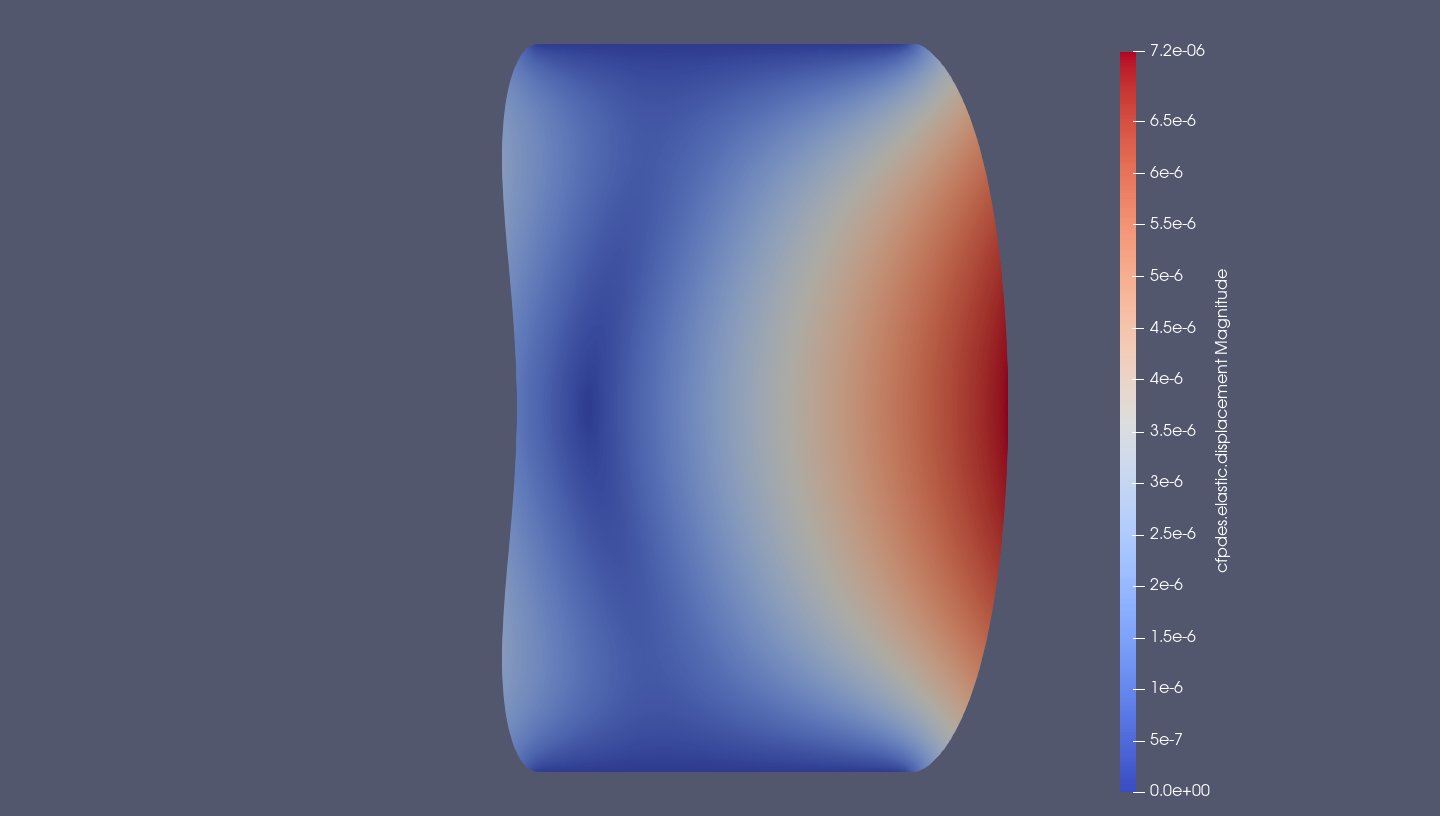
Deformation result of dilatation compute with cfpdes (with scale=1000) : the colours correspond to displacement
|
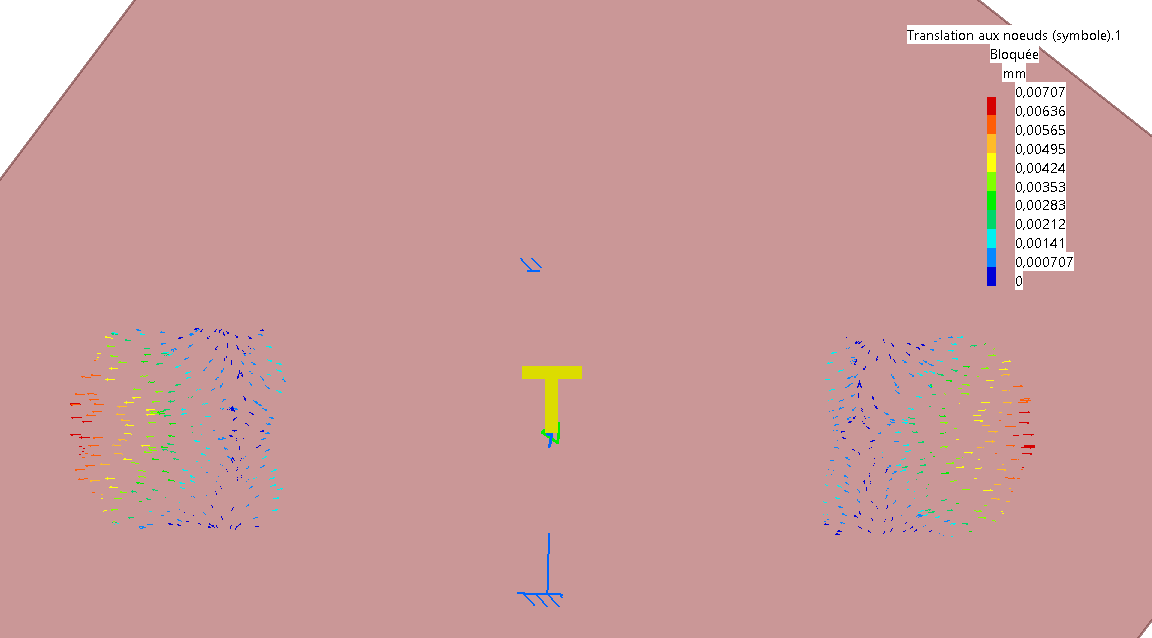
Deformation result of dilatation compute with catia : the colours correspond to displacement
|
The comparison isn’t reliable (visual comparison), the result of CFPDEs and CATIA have the form and the same order (near of center-exterior of torus, the displacement is around \(7.2 \, mm\) for the two results).
With comparison with CATIA, we have some confidence in this method.
